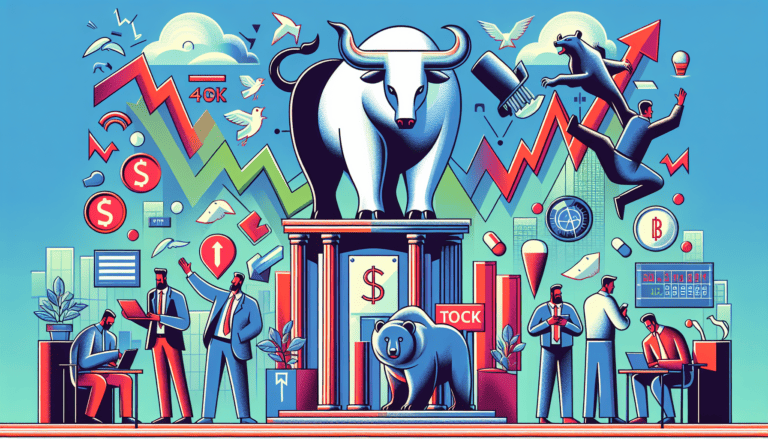Market Capitalization: The Key to Gauging Investment Potential

Understanding Market Capitalization
Defining Market Capitalization
Market capitalization, commonly referred to as market cap, is a key metric in finance that gauges the total value of a company’s equity. It reflects the aggregate value that the market assigns to a company’s outstanding shares. Market cap is often used as an indicator of a company’s size and can be a helpful factor in determining investment potential and comparing companies within the same industry or sector.
According to Investopedia, market capitalization is calculated by multiplying the current stock price by the total number of shares outstanding. This figure represents the total market value of a company’s equity and is a crucial component in various financial analyses and investment strategies.
Calculating Market Value
To calculate a company’s market capitalization, one must know two key pieces of information: the current market price of the company’s stock and the total number of shares outstanding. The formula is straightforward:
Market Capitalization = Current Stock Price × Total Number of Shares Outstanding
For instance, if a company has 100 million shares outstanding, and the current stock price is $50, the market capitalization would be:
Market Capitalization = $50 × 100,000,000
Market Capitalization = $5,000,000,000
This figure of $5 billion would place the company within a certain “cap” category, which is used to classify companies based on their total market value. Understanding these classifications is essential for stock market analysis techniques and making informed investment decisions.
The significance of market capitalization extends beyond just a measure of size; it also reflects the market’s perception of a company’s future prospects and ability to generate profits. As such, it can influence everything from initial public offerings (IPOs) to the company’s inclusion in major stock market indices.
By understanding market capitalization, beginner investors can better navigate the financial markets, whether they’re examining blue-chip stocks on major global stock exchanges or considering high-growth potential in smaller companies. It’s a fundamental concept that underpins much of the activity within the stock markets and exchanges, playing a pivotal role in the mechanics of stock trading and broader market dynamics.
The Role in Investor Decisions
Market capitalization is a pivotal metric that aids investors in making informed decisions about which stocks to purchase. It acts as a barometer for company size and the potential risks associated with an investment.
Assessing Company Size
When investors evaluate a company for potential investment, one of the first aspects they consider is the company’s size. Market capitalization offers a clear and immediate measure of a company’s size and is calculated by multiplying the current market price of a company’s shares by the total number of outstanding shares.
A company’s market cap can provide valuable insights into its stage in the business lifecycle, financial stability, and its ability to withstand market downturns. Companies with larger market caps are often well-established market leaders and may offer more stable investment opportunities. Conversely, companies with smaller market caps may be younger, potentially more volatile, but can also offer significant growth potential.
To compare companies within the same industry or sector, investors often look at market capitalization as a benchmark. This comparison can reveal which companies are the dominant players and which are the emerging challengers (Source). For more on how market size relates to stock exchanges, see understanding stock exchanges.
Evaluating Investment Risk
Market capitalization is an essential component in the assessment of investment risk. Generally, companies with larger market capitalizations tend to be more stable and less risky than those with smaller market caps. This stability stems from their established presence in the market, diversified product lines, and often, a global reach, which can protect against regional economic downturns.
While larger companies may provide a sense of security, they might also offer lower growth potential compared to their smaller counterparts. Smaller companies, categorized as small-cap, can be riskier due to their vulnerability to market fluctuations and limited resources. However, they often have higher growth potential, making them attractive to investors who have a higher risk tolerance and are looking for substantial returns.
Investors can use market capitalization to gauge both the risk and potential return of investing in a company. This understanding can help in constructing a diversified portfolio that aligns with an investor’s individual risk profile and long-term investment goals. For insights into risk management, investors can explore stock market risks and how to manage them.
Market capitalization’s significance in investment decisions cannot be overstated. It provides an indication of a company’s size, growth potential, stability, and overall market value—all crucial factors for investors to consider (Investopedia). Whether an investor is looking for stability, growth, or a balance of the two, market capitalization offers a vital piece of the puzzle in the decision-making process. For further reading on market valuation and investment strategies, one might delve into stock market analysis techniques.
Market Cap Classifications
Market capitalization is a critical metric in the investment world, providing insight into the size and value of a company. It is calculated by multiplying the current stock price by the total number of outstanding shares. This figure is used to categorize companies into different size groups, such as large-cap, mid-cap, and small-cap, which help investors assess the risk and return potential of different investments (Investopedia).
Large-Cap Companies
Large-cap companies are typically industry leaders with a market capitalization of $10 billion or more. They are known for their stability and often have a global presence. Investors may consider large-cap companies as relatively safer investments due to their established business models and consistent dividend payments. These firms are usually less volatile during market downturns and have a history of steady growth.
| Market Cap Range | Characteristics |
|---|---|
| $10 billion or more | Stable, established, global presence |
Large-cap companies are significant contributors to major stock market indices, and their performance is a bellwether for the overall health of the market. Investors interested in large-cap companies can learn more about their role in the major global stock exchanges.
Mid-Cap Companies
Mid-cap companies, with market capitalizations between $2 billion and $10 billion, offer a balance between the rapid growth potential of small-cap companies and the stability of large-cap companies. While these companies may not be as well-known as their larger counterparts, they often have the potential for significant growth and expansion. However, they can also present a higher risk as they may be more susceptible to market fluctuations.
| Market Cap Range | Characteristics |
|---|---|
| $2 billion to $10 billion | Growth potential, moderate stability |
For investors, mid-cap companies can be an attractive option for diversification. They can offer the possibility of higher returns, while still providing some level of security compared to smaller companies. Those interested in mid-cap companies can further explore the subject through articles on stock market analysis techniques.
Small-Cap Companies
Small-cap companies are generally young companies with a market capitalization of less than $2 billion. They are often characterized by their high growth potential, but also come with a higher risk due to their susceptibility to market volatility and less established positions in the market.
| Market Cap Range | Characteristics |
|---|---|
| Less than $2 billion | High growth potential, higher risk |
Investors who are willing to take on more risk for the possibility of higher returns may find small-cap companies appealing. However, it is vital for investors to conduct thorough research and consider the increased volatility and potential for loss associated with these smaller entities. For more information on navigating these risks, one can read about stock market risks and how to manage them.
Understanding the different market cap classifications is essential for investors looking to tailor their portfolios to their risk tolerance and investment goals. Each category offers distinct opportunities and challenges, and knowing where a company falls within these classifications can help inform better investment decisions.
Comparing Within Industries
Within the finance sector, particularly the stock market, market capitalization serves as a critical metric for comparing companies within the same industry. It allows investors to gauge a company’s size and make informed decisions by considering the investment risks associated with companies of varying market caps.
Benchmarking Company Value
Market capitalization is frequently used as a benchmark to contrast companies within similar industries or sectors. This metric offers a snapshot of a company’s market value, reflecting investors’ perceptions of its future prospects. Companies with a higher market capitalization are often regarded as more stable and dependable than those with a smaller market cap, as they are typically well-established entities within their respective fields. This perception of stability can influence investment choices, as investors may prefer the apparent security associated with larger, more established companies.
To compare market capitalization across different companies and sectors, consider the following table:
| Company | Industry | Market Capitalization (USD) |
|---|---|---|
| Company A | Technology | $500 Billion |
| Company B | Technology | $300 Billion |
| Company C | Health Care | $200 Billion |
| Company D | Health Care | $50 Billion |
This comparative approach helps investors understand a company’s relative size and standing within its industry, providing insight into its market dominance and competitive edge. For those new to investing, gaining a grasp of stock market analysis techniques can be beneficial in interpreting these figures.
Market Cap and Market Indices
Market capitalization also plays a pivotal role in determining a company’s inclusion in various stock market indices. Indices are used by investors to track the performance of a particular segment of the market and are often composed of companies that share similar market caps. For instance, large-cap companies might be included in a leading index such as the S&P 500, which represents a broad swath of the U.S. economy.
Understanding the relationship between market cap and market indices is essential for investors who use these indices as benchmarks for their own portfolios. As market cap reflects not just the value of a company but also its influence and importance in the market, being listed in a prominent index can enhance a company’s visibility and appeal to investors.
For a deeper dive into the world of indices and their impact on investment strategies, check out stock market indices explained.
Market capitalization’s significance extends beyond just a numerical value—it encapsulates investor sentiment and market trends, providing a clearer picture of a company’s stature in the financial ecosystem. Whether you’re a beginner investor or an experienced financial analyst, understanding market capitalization and its importance is crucial for making educated decisions in the stock market.
Fluctuations in Market Cap
Market capitalization, a critical financial metric, is not a fixed value but rather a dynamic figure that can shift with market conditions. Understanding these fluctuations is essential for beginner investors to make savvy investment decisions.
Factors Influencing Changes
Several factors can influence changes in a company’s market capitalization:
-
Stock Price Movements: The most direct influence on market cap is the change in a company’s stock price. As stock prices increase, market cap grows, and conversely, it shrinks when stock prices fall.
-
Outstanding Shares: If a company issues more shares or buys back existing shares, the number of outstanding shares changes, impacting market cap.
-
Market Sentiment: The collective perception and attitudes of investors toward a company or the broader market can lead to price volatility and, hence, market cap fluctuation.
-
Economic Indicators: Interest rates, inflation, and economic growth forecasts can affect investor confidence, leading to stock price adjustments.
-
Corporate Performance: Earnings reports, management changes, new product launches, or other company-specific news can result in a reevaluation of a stock’s worth.
-
Regulatory Environment: Changes in laws or regulations may impact a company’s potential for growth or profitability, altering its market cap.
-
Global Events: Geopolitical stability, international trade agreements, and global crises can also sway stock prices.
Investors should regularly monitor these elements to understand the direction in which a company’s market cap may be heading.
Monitoring Market Dynamics
To stay informed on market cap changes, investors should:
-
Keep Abreast of Financial News: Follow financial news updates, earnings reports, and industry developments closely.
-
Use Financial Analysis Tools: Utilize tools and stock market analysis techniques to dissect market trends and assess company performance.
-
Watch Market Indices: Indices like the S&P 500 or Dow Jones Industrial Average can serve as barometers for broader market movements (stock market indices explained).
-
Study Economic Calendars: Be aware of scheduled economic releases, such as employment statistics or central bank announcements, which may influence stock prices.
-
Engage with Community: Join investment forums or networks to discuss and gain insights into market perceptions and potential impacts on market cap.
-
Monitor Stock Exchanges: Understanding how major global stock exchanges operate can provide context for market cap fluctuations.
By maintaining vigilance on these fronts, investors can better navigate the ebbs and flows of market capitalization and its importance in the valuation of companies within the stock market.
Market Cap and Company Operations
Market capitalization is not only a metric for investors to gauge a company’s size but also a significant factor influencing company operations, particularly in terms of financing options and strategic growth decisions like mergers and acquisitions.
Impact on Financing and Capital
Market capitalization is a strong indicator of a company’s ability to attract investment and secure capital. Companies with a higher market capitalization often find it easier to access different types of financing, from equity to debt instruments. They can leverage their market value to issue new shares or bonds at favorable rates, thus raising capital more efficiently. Additionally, a robust market cap can enhance a company’s credibility and standing in the eyes of potential investors and financial institutions, leading to more favorable terms in financial dealings.
A larger market cap can also translate to better liquidity for a company’s stock, making it more attractive for institutional investors who require significant stakes without impacting the stock price too much. Moreover, these companies are more likely to pay out dividends, which further attracts a certain investor demographic interested in regular income (dividends: understanding stock income).
| Financing Type | Influence of High Market Cap |
|---|---|
| Equity Financing | Easier to issue new shares |
| Debt Financing | Lower interest rates on bonds |
| Dividend Payouts | More regular and attractive payouts |
Data Source: NetSuite
Importance in Mergers and Acquisitions
Market capitalization plays a critical role in mergers and acquisitions (M&As). Companies with substantial market caps often have more leverage when negotiating deals. They may use their stock as a currency for acquisitions, allowing them to preserve cash or avoid taking on additional debt. A high market cap can also make a company an appealing merger partner, as it implies stability and the promise of growth.
In the strategic planning of M&As, the market cap can serve as a tool for valuation, enabling companies to assess the worth of potential targets within their industry. This can be particularly useful for comparison when considering multiple acquisition targets or when trying to evaluate the fairness of a bid from a would-be acquirer.
| M&A Aspect | Influence of High Market Cap |
|---|---|
| Negotiation Leverage | Stronger bargaining power |
| Stock as Currency | Use of shares to finance deals |
| Attractiveness as a Partner | Seen as stable with growth potential |
Source: NetSuite
Market capitalization’s influence extends beyond just investment decisions; it is integral to the operational strategies of companies. Whether a business is looking to expand through initial public offerings (IPOs), seeking additional capital, or pursuing strategic M&As, market capitalization serves as a fundamental aspect of their financial maneuverability and overall corporate strategy. Understanding the nuances of market capitalization and its importance is crucial for beginner investors embarking on their journey in the financial markets, as it offers a window into the operational health and potential of investment targets.





